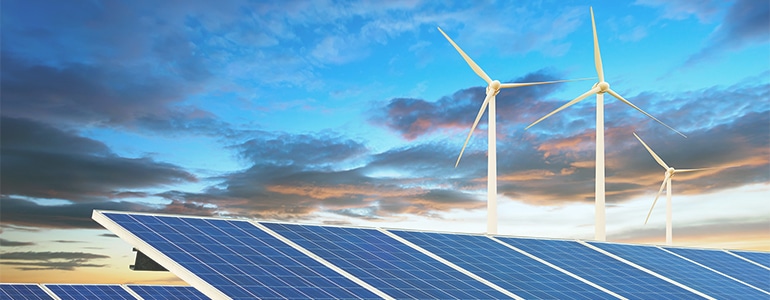
Which Renewable Energy Sources Are Most Reliable?
Table of contents
Five years ago, Born to Engineer shared some compelling statistics on the efficiency of renewable energy sources. They stated that the top five most efficient green energy sources are wind, geothermal, hydroelectric, nuclear, and solar. This calculation was made at the New Jersey Institute of Technology, based on the current cost of fuel, production, and dealing with environmental damages.
Check out this handy NJIT infographic on The Most Efficient Form of Renewable Energy
In this blog, we’ll look at these methods of producing green energy and try to understand which are the most reliable and sustainable renewable energy sources in 2022.
Solar Power
Solar power is one of the cleanest forms of energy because it does not emit any greenhouse gases. It also produces no harmful by-products. However, it is still relatively expensive compared to traditional methods of energy production.
Solar power systems are only capable of supplying electricity when fully exposed to the sun, making them unreliable at night and for anybody living in regions that experience prolonged darkness throughout the winter. Thermal solar power is more dependable but ineffective right now.
According to NREL research, solar panels are extremely reliable and have a long lifespan, only failing at a rate of 0.05 percent. On top of this, solar energy does not create any greenhouse gases or contribute to global warming because it only relies on capturing solar energy and transforming it into electricity (or hot water) for use in our homes. In a single year, it may cut the average home’s carbon impact by 80%.
Wind Power
Wind power is another form of renewable energy that has been used for centuries. In fact, wind turbines were first invented in China during the Tang Dynasty (AD 618–907). Today, wind power is an inexpensive source of energy that is becoming increasingly popular.
Since wind turbines may be easily installed offshore, wind power is often more dependable than solar electricity. But they only work when the wind is moving at a specific pace.
How sustainable is wind turbine manufacture? Well, the International Renewable Energy Agency expects millions of tonnes of used turbine blades to be in reuse by 2050. This is due to the absence of commercially viable recycling solutions and can only be put in place when lifetime and quality allow.
Impressively, wind turbines are 80-90% recyclable. But many of the current composite blades wind up in landfill. To combat this, turbine manufacturer, VESTAS, is researching composite recycling technologies with the aim of achieving zero-waste wind turbines by 2040.
Hydroelectricity
Hydropower plants run much the same as a coal-fired power plant does. By turning turbines with the force of water, hydropower facilities produce electricity.
For instance, the steam produced when coal is burnt in a coal plant powers turbines, which subsequently produce electricity. Water is used as the energy source in hydropower systems.
But the most well-known type of hydropower, usually referred to as hydroelectric power, is a sizable dam that stores water in a reservoir. Water is released from the reservoir when energy is required, and the water then drives turbines to generate electricity.
In addition to being a cost-effective source of renewable electricity, hydropower is also one of the most economical energy sources overall. Additionally, hydroelectricity is immune to the erratic price fluctuations of energy commodities since it harnesses the self-renewing force of rivers.
Geothermal Power
Geothermal power uses heat from the earth to produce electricity. It works well in areas with high temperatures because the temperature difference between the hot rocks underground and the surface creates an electric current.
At present, geothermal energy is largely untapped. However, it’s estimated that geothermal has the potential to meet up to 12% of the world’s demand for heating, cooling, and electricity.
So, what are the challenges that we must overcome to take advantage of this practically limitless source of energy?
Geothermal energy production can release greenhouse gases stored under the earth’s surface. It also needs to be properly managed through the maintenance of underground reservoirs and has one of the highest upfront costs.
But all this pales in comparison to the most controversial topic concerning geothermal energy. Hydraulic fracturing, or fracking, is a method for extracting oil, natural gas, geothermal energy, or water from deep underground.
It’s widely accepted that sustainable geothermal energy production should be restricted to locations where it is naturally available. Not least due to the risk of triggering earthquakes. One of the most active geothermal areas in the world is called the Ring of Fire, which encircles the Pacific Ocean.
In Our Experience…
The environment benefits directly the more we use renewable energy sources. They lessen our reliance on fossil fuels, which contribute to global warming and air pollution. However, they are influenced by the weather, and their energy is more difficult to store.
At present, wind power is the most efficient method of sustainable energy production. In fact, it’s more than twice as efficient as its closest competitor (geothermal).
But this isn’t to say that wind power is without its challenges and disadvantages. There are several engineering issues that need to be addressed before wind turbine manufacture can be considered truly sustainable.
The SIMULIA Wind Turbine Engineering solution helps simulation engineers to predict, optimize, and virtually test before prototyping.
Discover how to design, simulate, and manufacture sustainable wind turbines!



